HELLO + WELCOME as we make our way from Sydney to London, overland through Africa.
It’s Kirsty here today writing about our time tracking Ethiopian Wolves in the Bale Mountains.
![]()
We skidded into the border town between Kenya and Ethiopia to find the Kenyan custom guy taking a two hour lunch. This kind of thing is normal in Africa and we have learnt there is no point in questioning why other protocols aren’t in place. Like a revolutionary second customs guy?
Someone volunteered to raise him from the dead and we spent our last half hour in Kenya sitting by the dusty roadside showing children our Australian photo book.This little album has been used so frequently now it’s cover has fallen off. The usual shrieks and smiles erupted at the vision of kangaroos and our families. When we reached the page that shows beaches and lakes the children looked baffled. They live in Moyale after-all; no water around here.
We crossed into Ethiopia and I held my breath as the immigration official studied our visas that we had waited for a month to procure. He slammed down his stamp. And just like that, we were in!
Then the whole World changed! Tarred roads. Donkey carts. Children. Goats. Houses constructed in completely different ways with ornate paintings on the doors and windows. Gross squat toilets. A whole other level of non-cleanliness. And the best beer we have tasted in Africa! Ethiopia’s local brew St.George.
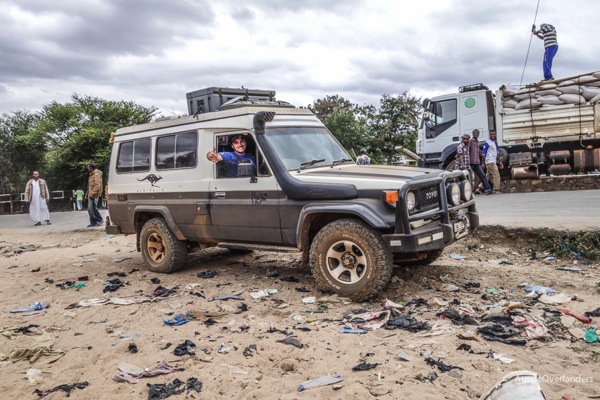
:: Quietest border yet. Complete with rubbish tip outside of immigration.
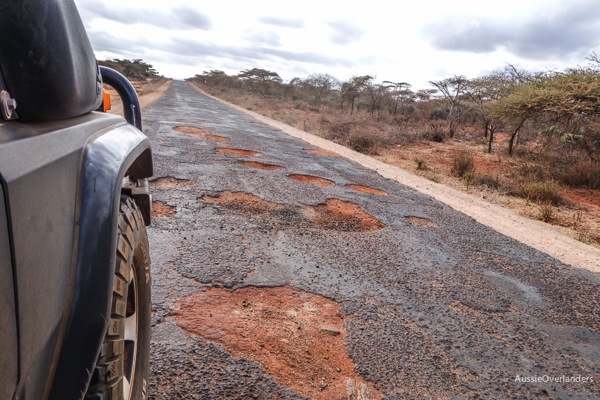
:: Pothole heaven

:: Homes of Southern Ethiopia

:: Homes of Southern Ethiopia

:: After we crossed into Ethiopia we realised we hadn’t eaten since 6am and were so happy to pull out the pre-cooked chicken and rice curry from the night before.
Our first major stop in Ethiopia was the Bale Mountains where we wanted to track the endangered Ethiopian Wolf. From the National Park headquarters the track was just 20-kilometres to the remote Webb Valley. An area known to be home to some of the 500 wolves remaining in the wild.
We were told that it was compulsory to take a guide to this region. This didn’t sit well with us. Firstly, we don’t have a third seat in the car. Secondly, “It’s just 20kms for goodness sake!”. And thirdly, we don’t like being babysat we just wanted to be alone!
Rules in most of Africa are made to be broken… but this one wasn’t budging.
But guess what? Within minutes of being on the track we were grateful for our guide. The track turned out not to be a track. Instead it was more of a… ‘Go through this paddock, turn left at the rocks, over that mountain, through that metre high water, up that 45 degree incline’, type of affair.
It was bordering on the rainy season so we also had slippery terrain to contend with. For the first hour there were no other vehicle tracks. That was when we enquired with our guide squashed in the back “Ahh, how many cars actually come through here?”, “You are number 3. All year” came the reply. Most people hike in or come on horses.
We crawled over mossy rocks in low-range gear (ultimate 4WD traction, baby) and passed women in burkas and muslim men on horseback. Children wore rags.
Once we made it through the remote village areas the vistas opened up and the landscape turned outrageously beautiful. On top of mountains you could spin 360′ and not see a soul or a settlement, “We are in the middle of nowhere, in the middle of nowhere (Ethiopia)”

:: Middle of nowhere, in the middle of nowhere (i.e. towards Webb Valley, Bale Mountains)

:: One of our favourite experiences in Africa right there

:: Don’t mistake these for vehicle tracks. These are goat tracks.

:: When we passed horses they began to freak out. Being the the third vehicle all year – some of the animals clearly didn’t know what the hell Troopy was! On a few occasions we just turned the car off and let the animals pass to calm them down.

:: Horseback travel is the norm
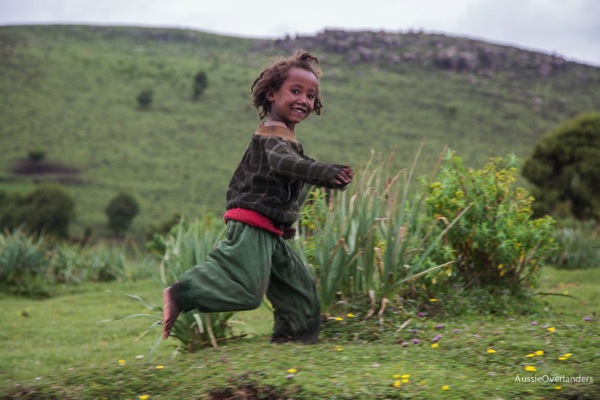
:: Hello, farange!
After four hours driving ‘the 20km track’ we saw our first Ethiopian wolves. Handsome and red, with white and black markings. We saw them from the car and then jumped out to walk closer. They hid behind a group of cows to hunt Mole Rats. The land here is dotted with tunnels dug by the rats and the wolves have worked out if they hang by the cows they have a better chance of catching dinner.
Soon after we made it to our camp besides the Ethiopian Wolf Conservation Project hut and couldn’t believe how beautiful ihe area was. It was a landscape neither of us have seen before – endless light green mountains covered with short grass and unusual plants. The light here seemed to make everything glow.
It felt very special to be the only travellers in the park and to have the entire place to ourselves. As luck would have it the local manager of the conservation project was also quite excited we had come. And joined us for an afternoon trek into the mountains to find some more wolves.
Zaghir is a passionate guy who lives out in the mountains for weeks at a time. He observes the behaviour of the wolves and the habitat and reports back to the internationally funded organisation.
While we tracked the wolves he explained the number one imminent threat to their survival is contracting rabies from village dogs. They are trying to vaccinate the dogs and the wolves but this is met with a lot of apathy and resistance from the local people and the government. The situation seems stupidly frustrating. Not to mention dire.
The secondary, and longer term threat, is encroachment on the wolves environment. We saw this first hand. Even though the Bale Mountains is a National Park there are villages within the park and pastoralists walk around with their huge herds of cows. The villagers don’t kill the wolves but they are interfering with their environment. We saw this first hand which obviously has a snowball affect on the ecology of the environment and the wolves behaviour.
During our stay we saw 9 wolves. No less than 1.8% of the entire population.
As sun set Gareth and I took a hike by ourselves around the valley and later fell asleep while trying to keep warm in the freezing temperatures. The night was so quiet all we could hear was the calls of the Ethiopian wolves. You could only hope that this is a sound future generations get to hear too.
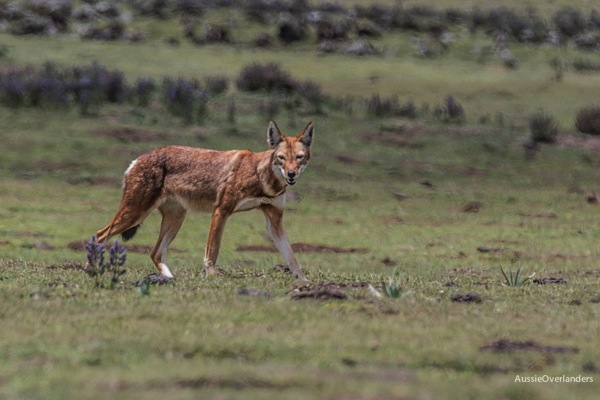
:: Ethiopian Wolf

:: Tracking wolves

:: Walking around before sunset by ourselves in the Webb Valley

:: Muslim’s fasting season of Ramadan was soon coming to an end. And as I cooked up our mixed bag of a lunch the muslim wolf trackers decided to pray just 5 metres from the car to inhale the fumes!
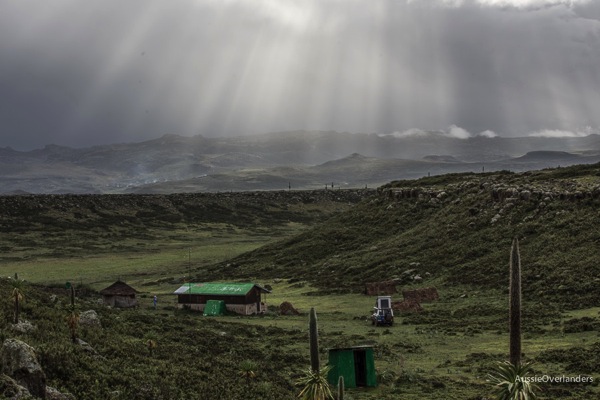
:: Home for the night camped by the Ethiopian Wolf Research hut.
![]()
As always, thanks for being here guys. We hope you enjoyed the read.
If you would like to find out more about the Ethiopian Wolf please take a look at www.ethiopianwolf.org
Cheers,
![]()


